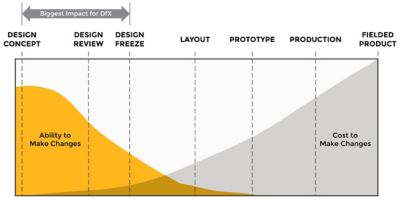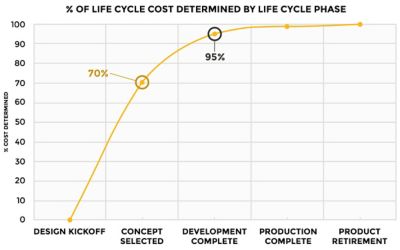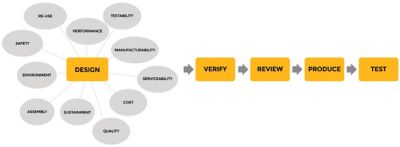-
United States -
United Kingdom -
India -
France -
Deutschland -
Italia -
日本 -
대한민국 -
中国 -
台灣
-
-
产品组合
查看所有产品Ansys致力于通过向学生提供免费的仿真工程软件来助力他们获得成功。
-
Ansys博客
June 21, 2023
什么是卓越设计(DfX)?
工程师经常谈论卓越设计(DfX)的重要性,以及它对产品整体上市进程、现场可靠性和客户满意度的影响。DfX可以对业务和设计的成功产生重大影响,因此了解其方法及实施方式是很有价值的。让我们来了解一下DfX的基本原理以及企业如何利用它来发挥最大优势。
卓越设计是一种系统化、主动的设计方法,它利用产品开发流程中其他环节(例如测试、制造、运营和支持)专家的知识和经验,以确保最终产品能够以合理的低生命周期成本实现,同时仍能满足可靠性、质量、耐用性和客户期望目标。
卓越设计的前提是,首次即正确设计产品的成本远远低于在产品开发后期或在客户层面发现故障的成本。通过在设计阶段早期评估产品基本功能之外的问题,鲁棒性DfX方法的实践者可以显著减少缺陷、废品、返工、重新测试,并提高产品产量。

在设计阶段早期实施DfX,可确保在原型构建之前快速进行更改,从而节省时间和成本。
DfX的优势
产品差异化:随着电子技术日臻成熟,产品越来越难以通过价格和性能等传统优势从竞争中脱颖而出。DfX方法使企业能够保持较低的生产和支持成本,同时实现令其客户满意的出色可靠性和耐用性。
可靠性保证:先进的电路、复杂的电源要求、新的组件、新的材料技术和不太稳健的部件,都使确保可靠性变得越来越困难。实施DfX方法,包括经过深思熟虑的可靠性设计(DfR)、面向使用环境的设计(DfE)和测试设计(DfT)计划,可显著降低确保可靠性的成本,并降低在测试中或现场发生意外故障的风险。
成本控制:虽然成本因产品而异,但新产品的成本有70%是由产品设计理念决定的。当设计流程完成时,高达95%的产品生命周期成本已锁定。之后的设计变更不仅成本高昂,而且还会对预生产计划成本和产品发布时间产生负面影响。
通过使用DfX方法,企业可以应用从制造、装配、测试、包装、维护和维修、实际使用环境以及与设计无关的其他领域中获得的专业知识和经验教训,以最大限度地降低设计、制造和支持成本。

新产品导入(NPI)成本的70%取决于选定的设计概念。当设计流程完成时,95%的产品开发成本已锁定。
加速产品上市进程:尤其是在竞争激烈的市场中,快速将客户想要和需要的产品推向市场对于领先竞争对手和抢占市场份额至关重要。快速进入市场,以及成为市场上最好的产品之一,这两者之间很难取得平衡,而有效的DfX策略可以更容易实现这种平衡。
重新设计、测试失败以及装配和制造问题都会占用新产品导入计划的宝贵时间。DfX方法为设计带来一种并行的工程理念,该理念考虑到每个产品开发阶段的需求,以创建一种能够在发布前阶段顺利进行的设计,并将与设计相关的障碍降至最低。
何时使用DfX?
DFX原理可应用于产品生命周期中进行设计的任何时期,包括初始设计和重新设计。当然,对于任何新产品导入(NPI),DfX实践都应在设计阶段尽早实施。对于现场产品或已经进入产品开发其他阶段的产品,在需要重新设计时考虑DfX方法也永远不会太晚。
新产品导入:由于感知成本或对扼杀创造力和创新力的担忧,在设计的早期概念阶段实施DfX可能会遇到一些阻力,但尽早引入DfX专家和吸取经验教训对于实现效益最大化至关重要。即使在概念阶段,也必须提出以下问题:
- 设计会对可靠性产生什么影响?
- 是否需要发明新技术来实现此设计?
- 此设计带来了哪些制造挑战?
- 如何支持现场产品?
尽管这些考虑因素与概念设计相去甚远,但它们对于设计概念的权衡以及让设计阶段朝着正确的方向开始至关重要。至少,在确定详细的设计要求之前,DfX计划应完全生效。
产品开发中期:如果产品在很大程度上已完成设计阶段,但在预生产、测试或制造过程中遇到需要重新设计才能解决的问题,DfX实践可帮助确保下一次重新设计将是最后一次。在这一阶段运用DfX专业知识有助于确定导致重新设计的真正根本原因,并使设计更适合进行测试、制造、装配、部署、维修等。
现场产品:作为前瞻性产品改进计划的一部分,或为了解决现场可靠性、性能、可维护性或安全问题而进行重新设计的现场产品,也可以从DfX实践中受益。确定任何问题的根本原因并制定重新设计的要求是关键任务,DfX方法可以最大限度地减少重新设计工作的成本和时间。
谁应该参与DfX?
虽然DfX方法需要专家的知识,但成功的设计团队可确保团队中的每个人都了解、实施DfX方法并看到其价值。成功的DfX团队会以设计要求、设计规则和团队成员培训的形式获取和使用专家知识,以确保团队中的每个人都在使用DfX最佳实践。为了让专家帮助解决新问题,在遇到关键设计节点时,应该让他们参与进来,以帮助识别风险并制定缓解策略。
根据企业的规模和结构,人员职务可能有所不同,但DfX计划的主要参与者,应具备组件选择和采购、可靠性物理、装配和制造、测试、现场支持实践和物流以及使用环境和压力源等方面的专业知识。根据产品及其预期用途,热管理、适用的环境法规、安全、再利用和回收以及成本管理等领域的专业知识也可能有所帮助。
DfX最佳实践
尽早开始。在设计流程早期实施DfX实践,以更低的生命周期成本生产出更高质量的产品,并缩短产品上市进程。等待的时间越长,DfX对最终产品的影响就越小。

DfX有助于在设计早期预防问题,而不是在产品开发流程的后期解决问题和重新设计。
人员、流程与工具。从零开始并非易事。一个可靠的DfX计划需要:
- 拥有正确专业知识、培训和持续改进心态的人员。
- 记录完备、易于访问的标准化流程,其中包含最佳实践和经验教训。
- 标准工具,使设计团队中的每个人都能轻松利用专业知识。事实上,一个精心设计的DfX计划应该意味着,在设计流程中使用更少而不是更多的工具。
只用您需要的技术。目前有近50种不同的DfX实践(取决于您所咨询的对象)。好消息是,您通常只需要几种就能对产品开发流程产生积极影响。可靠性设计(DfR)、可制造性设计(DfM)、可测试性设计(DfT)和可持续性设计(DfS)是电子行业中最常用的DfX实践。如果您目前没有使用DfX方法,请考虑仅实施其中一种经过验证的技术。
Ansys拥有可靠性专家提供的一系列有用资源,可帮助您应对DfR挑战。探索我们的可靠性设计资源。










